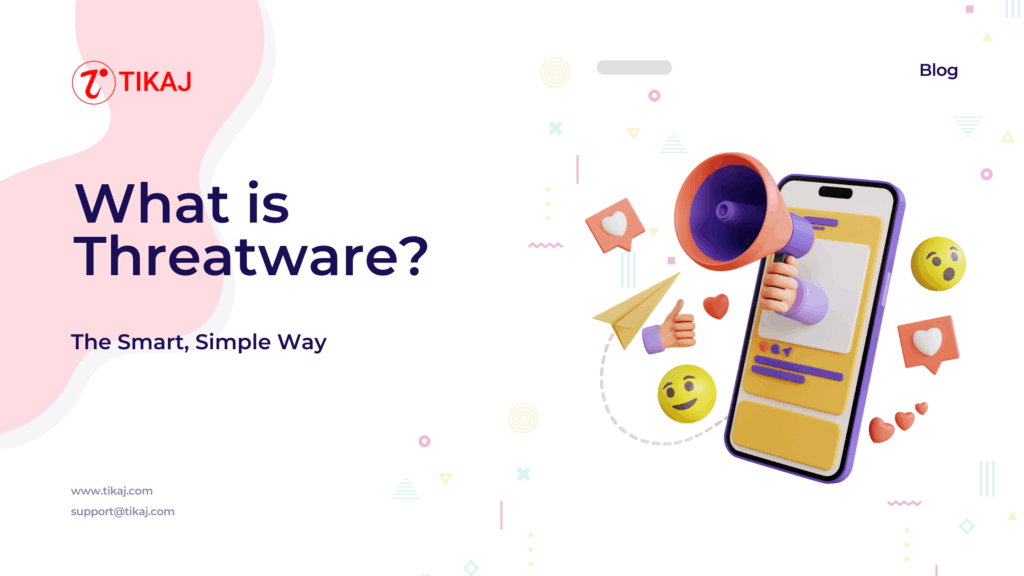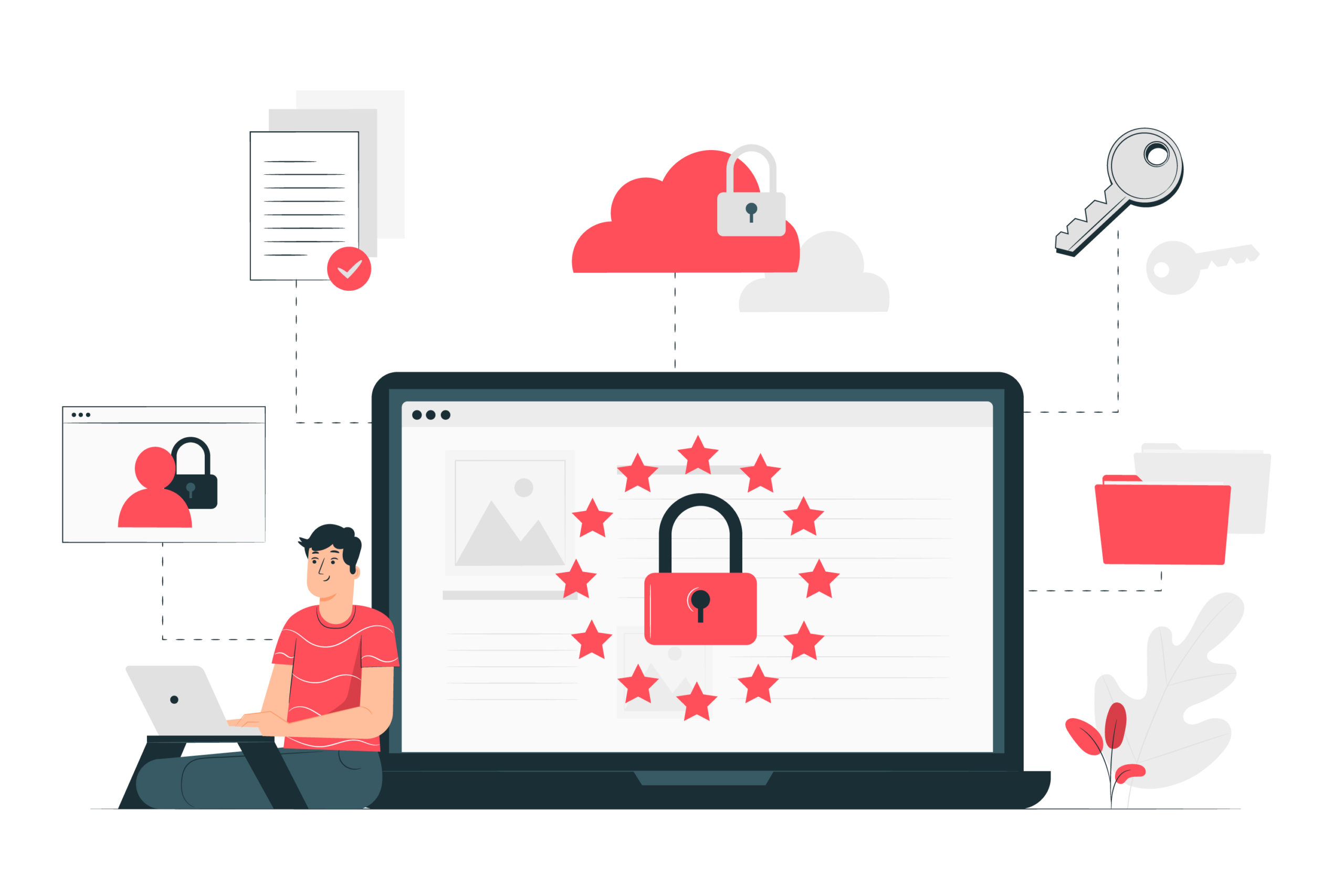Understanding Threatware: Identification, Prevention, and Survival (2025)

As organizations digitize faster than ever in 2025, cybersecurity risks are escalating in both volume and complexity. Sophisticated malware strains, fileless attacks, and AI-powered phishing campaigns are no longer rare; they’re part of the everyday threat landscape. Industries like banking, fintech, and e-commerce are particularly at risk, with attackers targeting data, infrastructure, and trust. Understanding and responding to modern cyber threats like threatware is critical in this high-stakes environment.
In this blog, we have broken down what is threatware, how it works, and what steps businesses must take to defend themselves effectively.
Table of Contents
What is Threatware?
Threatware, a term often used interchangeably with malware, refers to software designed to harm, exploit, or disrupt computer systems, networks, or data. This can include viruses, worms, trojans, spyware, adware, ransomware, and other types of malicious software. The primary goal of threatware is to compromise the security, integrity, or availability of the targeted system or data, often for financial gain, espionage, or simply to cause disruption.
How Does Threatware Work? Understanding the Lifecycle of Threatware
Its operation typically follows a multi-phase lifecycle, from initial infection to remote control by the attacker. Here’s how threatware works, step by step:
Infection Vectors: How Threatware Enters Your System
The first stage in threatware’s lifecycle is delivery through an infection vector. Common vectors include phishing emails that deceive users into clicking malicious links or downloading infected attachments. Another method is drive-by downloads, where simply visiting a compromised website results in malware being installed via browser vulnerabilities. Users may also become infected by installing tampered software from untrusted sources, or by connecting infected USB devices. These vectors exploit both technical and human weaknesses to gain initial access.
Execution & Propagation: Activating and Spreading Malware
Once inside the system, the threatware executes its payload, activating the core malicious code. At this point, it may exploit software vulnerabilities to escalate privileges, gain persistence, or move laterally within a network. Some variants replicate themselves, infecting other systems, files, or devices. In many cases, attackers use social engineering to convince users to perform actions that aid the malware, such as disabling antivirus protection or granting unnecessary permissions. The goal here is to spread, gain control, and remain undetected.
Evasion Techniques: Avoiding Detection
Modern threatware is designed to evade traditional detection tools. It may use code obfuscation to disguise its logic and avoid signature-based detection. Encryption is often employed to protect its communication with external servers or to hide its presence on disk. In more advanced cases, the malware is polymorphic; it alters its code slightly with each infection to stay under the radar. Some also use a technique called “Living Off the Land” (LOTL), which involves using legitimate system tools (like PowerShell or Task Scheduler) to blend in with normal operations.
Payload Activation: Executing the Malicious Intent
The core function of threatware lies in its payload, which varies based on intent. Some payloads are designed to steal data such as passwords, credit card details, or sensitive documents. Others are used to encrypt files and demand a ransom, known as ransomware. In certain cases, the system is silently added to a botnet to participate in large-scale DDoS attacks or spam campaigns. Spyware variants might monitor user activity, track keystrokes, or capture screenshots, especially in corporate or political espionage campaigns.
Command & Control (C2): Remote Management by Attackers
Advanced threatware often establishes a command and control (C2) channel with its origin server, allowing attackers to control the infected system remotely. Through this channel, attackers can issue commands, extract stolen data, or deploy new malicious modules. The communication may be encrypted and occur at irregular intervals to avoid detection. This ongoing access enables attackers to maintain persistence, adapt their strategies, and even coordinate multiple infected systems across a network.
Types of Threatware
Threatware, or malware, exists in various forms. Each is designed to execute specific malicious objectives. From data theft and system disruption to unauthorized surveillance and financial fraud, understanding these types is key to building effective cybersecurity defenses. Here’s a breakdown of the most common types of threatware encountered in 2025:
Viruses
Viruses are one of the oldest forms of malware. They replicate by attaching themselves to legitimate programs or files and activate when those files are opened. Once triggered, a virus can delete data, corrupt systems, or degrade performance. Commonly spread through infected email attachments, pirated software, or USB drives, viruses can range from harmless pranks to destructive attacks that crash entire networks.
Worms
Unlike viruses, worms don’t need a host file or user interaction to spread. They self-replicate and move independently across networks by exploiting operating system vulnerabilities. Worms can consume bandwidth and system resources, degrade performance, and serve as delivery mechanisms for payloads like ransomware or spyware. Notorious worms like WannaCry and Stuxnet caused global disruptions by exploiting unpatched systems.
Trojans
Trojans disguise themselves as legitimate software or files to trick users into installing them. Once inside, they can steal data, spy on users, or open backdoors for other malware. Trojans do not replicate like viruses or worms, but their deceptive nature makes them highly dangerous. They’re commonly delivered via phishing emails or malicious downloads.
Spyware
Spyware silently monitors user activity, often without the victim’s knowledge. It can track browsing habits, record keystrokes, and capture login credentials or financial information. Spyware is often bundled with free software or unknowingly installed through malicious ads, posing serious threats to privacy and data security.
Adware
Adware displays unsolicited advertisements, typically as pop-ups or banners. While not always harmful, some adware collects user behavior data for targeted advertising, often without consent. It’s usually installed alongside free or pirated software. Though less severe than ransomware, excessive adware can slow systems and open doors to more malicious threats.
Ransomware
Ransomware is among the most financially damaging types of malware. It encrypts files on a victim’s system and demands payment, usually in cryptocurrency, for the decryption key. These attacks often begin with phishing emails or vulnerabilities in remote desktop protocols. Businesses hit by ransomware often face extended downtime, data loss, and reputational damage.
Rootkits
Rootkits are stealthy malware designed to hide the existence of other malicious programs. They embed deep within a system, often at the kernel level, making them hard to detect or remove. Rootkits allow attackers persistent access while bypassing traditional security tools, making them a favorite for long-term espionage campaigns.
Logic Bombs
Logic bombs are malicious code snippets programmed to activate under specific conditions, such as a date or system event. They often remain dormant until triggered, making them difficult to identify during normal operations. Once activated, they can delete data, crash systems, or execute other harmful commands.
Fileless Malware
Unlike traditional malware, fileless malware operates in memory rather than being written to disk. It uses built-in system tools like PowerShell or WMI to perform malicious tasks, making it extremely difficult to detect using conventional antivirus software. Its stealth and persistence make it a growing concern in enterprise environments.
Botnets
Botnets are networks of infected devices controlled remotely by attackers. These devices, or “bots,” are used to carry out coordinated attacks such as DDoS, mass spam campaigns, or distribute additional malware. Botnets compromise device performance and are often difficult to dismantle due to their distributed nature.
Why is Threatware Dangerous?
Threatware poses significant risks to both businesses and individuals, leading to financial losses, data compromise, and long-term reputational damage. Its effects can ripple well beyond the initial infection by disrupting operations, triggering legal liabilities, and undermining stakeholder trust.
A prime example is the WannaCry ransomware attack in May 2017, which affected over 230,000 computers across more than 150 countries. Major organizations including NHS trusts in England and Scotland, FedEx, Telefonica, Deutsche Bahn, Nissan, and Renault had their operations crippled. NHS services faced cascading effects like canceled appointments, diverted ambulance services, and doctors reverting to pen-and-paper systems. The attack exploited the unpatched EternalBlue SMB vulnerability in Windows, despite patches being available two months prior.
The broader implications were staggering:
- Around 40 NHS trusts were severely impacted, leading to a 6% drop in hospital admissions and the cancellation of thousands of outpatient sessions.
- FedEx and Deutsche Bahn reported major logistics and tracking disruptions, affecting global supply chains.
- The estimated total economic losses reached up to $4 billion globally according to Wikipedia reports.
This incident underscores how threatware doesn’t just encrypt data; it halts critical infrastructure, undermines public services, and triggers widespread financial and societal consequences.
You can also read – 5 Essential Dark Web Marketplaces You Should Know
How to Protect Against Threatware
Protecting your organization from threatware requires a layered, proactive cybersecurity approach. Below are key strategies, both preventive and responsive, that can help reduce your risk of malware infections and limit their impact:
1. Regular Software Updates and Patching
Keeping all operating systems, applications, and firmware up to date is the first line of defense. Many threatware campaigns exploit known vulnerabilities in unpatched software. Implementing automated patch management systems can help reduce delays and human error.
2. Email Filtering and Anti-Spam Gateways
Since phishing remains a primary infection vector, deploying intelligent email filtering solutions can help block malicious attachments, links, and spoofed sender addresses. Advanced filters use AI to analyze patterns and stop emerging phishing tactics.
3. Endpoint Protection and EDR Solutions
Deploy enterprise-grade antivirus and anti-malware solutions across all endpoints. Even better, use Endpoint Detection and Response (EDR) tools that provide continuous monitoring, behavioral analysis, and rapid response to anomalies on devices.
4. Employee Training and Cyber Hygiene
Employees are often the weakest link. Regular training on identifying suspicious emails, avoiding risky downloads, and practicing safe browsing is critical. Simulated phishing campaigns can reinforce learning and test resilience.
5. Network Segmentation and Access Control
Segmenting your network ensures that if malware infiltrates one area, it cannot easily move laterally. Implement the principle of least privilege (PoLP) for user access, and use firewalls to enforce segmentation policies across critical systems.
6. Real-Time Threat Monitoring and SIEM Integration
Deploy a Security Information and Event Management (SIEM) system to aggregate logs, detect anomalies, and alert your security team of potential breaches. For larger environments, Security Operations Centers (SOCs) or XDR (Extended Detection and Response) platforms can provide centralized visibility and threat correlation across endpoints, cloud, and network layers.
7. Incident Response Plan and Recovery Readiness
Have a well-documented and regularly tested incident response plan in place. This should outline steps for containment, eradication, recovery, and post-incident review. Also, ensure you maintain secure, offline backups to restore critical systems quickly if ransomware hits.
Why Should Banks, NBFCs, Fintech, and E-commerce Firms Be Concerned?
Financial institutions and digital commerce platforms hold vast amounts of sensitive data ranging from personally identifiable information (PII) and financial records to transaction logs and proprietary algorithms. This makes them highly attractive targets for cybercriminals seeking financial gain, access to secure systems, or valuable data for resale on the dark web.
Banks, for example, face direct threats due to the sheer volume of monetary assets and customer data they hold. Attackers often target core banking infrastructure to execute fraud, siphon funds, or disrupt essential services. Additionally, the tightly regulated nature of banking means that a single breach could result in legal consequences, reputational damage, and customer attrition.
Non-Banking Financial Companies (NBFCs) often operate with fewer cybersecurity controls than traditional banks, making them more vulnerable. Many NBFCs rely on legacy systems or insufficiently monitored digital platforms, offering attackers easier entry points. Their growing role in consumer lending and digital finance also makes them appealing targets.
Fintech firms, being digital-first by design, are exposed to a broad array of cyber risks. From insecure APIs and cloud misconfigurations to mobile app vulnerabilities, fintechs must protect both innovative technology and customer data. Additionally, they are often under investor scrutiny, meaning that any breach could jeopardize funding and market confidence.
E-commerce platforms process thousands of online transactions daily, making them prime ground for cyber threats such as payment fraud, credential stuffing, bot attacks, and identity theft. A single data breach involving customer records can result in large-scale churn, chargebacks, and reputational fallout that significantly affects brand loyalty.
In short, as these sectors continue to digitize and scale, so does their attack surface, making it imperative to adopt advanced cybersecurity practices tailored to their operational needs.
Conclusion
In a landscape where digital transformation accelerates at breakneck speed, awareness and preparedness are your best defense. Threatware is not a distant problem for the IT team alone; it is a boardroom issue, a compliance concern, and a customer trust factor. For banks, NBFCs, fintech disruptors, and e-commerce businesses, understanding and mitigating threatware isn’t just smart; it’s essential for survival and sustainable growth.
As cyber threats evolve, so must your cybersecurity strategy. Prioritize continuous monitoring, invest in employee training, and foster a culture of digital vigilance. After all, when it comes to threatware, it’s not a question of if you’ll be targeted, but when. The time to act is now.
Frequently Asked Questions (FAQs)
1. How can businesses detect fileless malware that doesn’t leave a footprint?
Fileless malware lives in memory and uses legitimate tools like PowerShell. Traditional antivirus won’t catch it. Detection requires behavioral analytics, Endpoint Detection and Response (EDR), and Security Information and Event Management (SIEM) platforms.
2. Are cloud-based systems more vulnerable to threatware?
Cloud environments can be vulnerable if misconfigured. Threatware often exploits weak API security, poor IAM (Identity & Access Management), or unpatched services in cloud-hosted apps. However, with proper controls, cloud systems can be more secure than on-prem.
3. How does threatware bypass security tools like antivirus?
Threatware uses techniques such as polymorphism (code mutation), encryption, rootkits, and fileless execution to evade signature-based detection. It may also abuse trusted system tools to mask its activity, making it harder to flag as malicious.
4. What should be included in a threatware-specific incident response plan?
A robust plan should include threat classification, containment protocols, forensic analysis procedures, data recovery steps, and a communication strategy. It should also integrate tools like EDR, SIEM, and automated playbooks for faster response.






